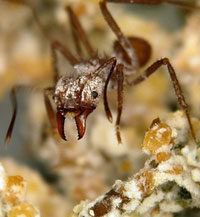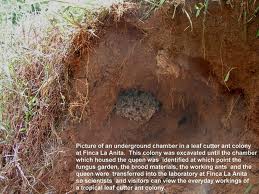Leafcutter ants, fungi, and bacteria
Introduction
Microorganisms often require a symbiotic relationship with other organisms in order to reproduce and survive. This symbiotic relationship is shown through the relationship between leafcutter ants, fungi, and bacteria. Sometimes refered to as the "First Agriculture," this relationship can be compared to farmer (the ants) cultivating its crops (the fungus). Up until recently, the fungal colonies seemed to be free of any pests or parasites. This was thought to be because the ants were so diligent in caring for the fungus that they did not allow any parasites to enter and take hold. Cameron Currie was the first to look at why the nests were pest free. He concluded that the ants carried a white powdery bacteria on their abdomens that had antimicrobial properties. Without the ants, the parasitic mold could take over the fungus in the colony in a matter of days.
Symbiotic Processes
Provide details of the symbiosis or biological interaction. Is this a specific or general interaction? How do these interactions influence the host or other microbial populations, and their activities? How do these interactions influence other organisms (positive or negative influences)? What is the outcome of this interaction? Are there ecological consequences? Describe biological interactions using as many sections/subsections as you require. Look at other topics available in MicrobeWiki. Create links where relevant.
What microbial processes are important for this microbial interaction? Does this microbial interaction have some ecosystem-level effects? Does this interaction affect the environment in any way? Describe critical microbial processes or activities that are important in this interaction, adding sections/subsections as needed. Look at other topics in MicrobeWiki. Are some of these processes already described? Create links where relevant.
Main Functions
The fungus and the ants depend on each other for survival. The ants cultivate the fungus in its colonies from chewed up leaves and at the same time the fungus acts as the main food source for the ants. One symbiotic partner can not survive without the other.
Fungi Growth
The leaves in the rain forest have toxic qualities in them which is supposed to deter herbivory. But the harvesting ants cut the leaves without ingesting any of the toxins and are able to bring the leaves back to the nest. There the leaves are given to worker ants which chew up the leaves in their mouths into a paste which becomes the food source for the fungus. The plant material is broken down through enzymes that break down the proteins and starches. Depending on the colony, the enzymes can slightly different between complete plant break down and those that focus mainly on plant wall digestion. Because of the symbiotic relationship, the toxins in the leaves are broken down by the fungi into needed sugars and proteins safe for the ant to consume.
Bacterial resistance to fungal parasites
To maintain a clean and healthy fungus colony, the ants have an outer bacteria which they use when cultivating the fungus. Some ants have this on their underbelly while ants that are in constant contact with the fungus are almost completely covered with the bacteria. This bacteria is similar to Streptomyces which is produces half the antibiotics made today. The antibiotic qualities allow it to specifically work with the fungus to inhibit the parasitic mold.
Environmental Implications
Nitrogen Fixation
Like any other garden, the ant's fungus garden needs nitrogen. Because of the low nitrogen ratio in leaves, there are nitrogen fixing bacteria in the colonies that help to introduce usable nitrogen into the system. The n-fixing bacteria fixes enough nitrogen for the fungus and the ants and also leaves a large amount in the refuse of the colony. This nitrogen can be worked back into the surrounding system replenishing the nutrient poor tropical environment with an essential limiting nutrient.
Niche
Habitat
The ant's nests are subterranean and can be found in mostly tropical areas including Costa Rica, Panama, and Argentina.
Nest Characteristics
Nests begin when a queen ant leaves one nest with a small amount of the fungus in her mouth and moves to a different area to start her own colony. Once a nest becomes established, the colonies can grow to have millions of ants in them.
These subterranean nests vary in sizes. They can be small with a single fungus growing "room" or can be multiple feet below ground with many different rooms and complex tunnels. Ants are also known as organized and clean insects. They have certain refuse dumps where the worker ants take the garbage and seclude it from the rest of the colony to decrease contamination.
Key Microorganisms
What specific kinds of microbes are typically involved in this interaction? Or associated with important processes? Describe key groups (genera, species) of microbes that we find in this environment, and any special adaptations they may have evolved to survive in this environment. List examples of specific microbes that represent key groups or are associated with important processes found in this environment. Add sections/subsections as needed. Look at other microbe listings in MicrobeWiki. Are some of the groups of microbes from your environment already described? Create links to other MicrobeWiki pages where possible.
Ants
The group of ants that are LeafCutters belong to the tribe attini. Their genera is Atta and acromyrmex Interestingly, these ants are consume the largest amount of primary producers in the tropical rainforest areas which is not surprising considering their biomass is four times the amount of other invertebrates. World wide, these insects take up a third of the total insect biomass.
Fungi
Playing the role of both a decomposer and the primary food source for the Leafcutters, the fungi from the family Lepiotaceae is grown underground in the nests chambers by the worker ants.
Parasites
Battling against the ant's seemingly clean fungis' agriculture are parasites that would quickly take over the colony's fungus growth if not carefully weeded against. These parasites are refered to as escovopsis would feed on the fungus.
Bacteria
One of the most interesting and only recently discovered partners is the antibiotic producing bacteria pseudonocardia
There has recently been research conducted on a fourth bacterial partner. This is a black mold that can be found on the cuticle of the ant and is used in a similar fashion in discouraging parasitic growth. This mold works like other fungis cultivating symbiots and helps to discourage the growth of parasites on the fungus.
Current Research
Coevolution between attine ants and actinomycete bacteria
It has been the thought that the close relationship between the ant and the bacteria has caused the two to evolve together. But the study looks at if that is truly so. It concluded that the ant has probably evolved with the bacteria, but the bacteria has evolved independently. The study states that more research needs to be done on the reciprocality of the evolving partners.
Enzyme activity activity in different ant colonies
Ants have evolved into different sister clades. This research shows how the enzyme activity between lower and higher evolved colonies has changed. The study shows that higher evolved colonies contain more protein and starch digesting enzymes while those of lower clades have enzymes that just focus on partial degradation of the plant material.
References
Ask Nature, A project of the Biomimicry Institute. <http://www.asknature.org/strategy/6392180f395ab3f04ee8dd8b3ce632c4> Dash, D., Mueller, U., Rabeling, C.,Rodrigues, A., 2008. "COEVOLUTION BETWEEN ATTINE ANTS AND ACTINOMYCETE BACTERIA: A REEVALUATION." Evolution 62. 11:2894-2912. Academic Search Premier. EBSCO. Web. 5 Apr. 2011.
De Fine Licht, H. H., Schiøtt, M., Mueller, U. G., & Boomsma, J. J. (2010). EVOLUTIONARY TRANSITIONS IN ENZYME ACTIVITY OF ANT FUNGUS GARDENS. Evolution, 64(7), 2055-2069.
Pinto-Tomas, A., Anderson, M., Suen, G., Stevensen, D., Chu, F., Cleland, W., Weimer, P., Currie, C. 2009. “Symbiotic Nitrogen Fixation in the Fungus Gardens of Leaf-Cutter Ants.” Science. 326: 1120-1123.
Edited by <Katie Yi>, a student of Angela Kent at the University of Illinois at Urbana-Champaign.


